Guide to Buying the Right Light Bulb
With technology ever changing and progressing, it’s often hard to keep up with all the new options and style ands trends and - well, there are a lot of things to consider, even when picking out a light bulb.
Gone are the days of popping down to the shops and getting a replacement incandescent bulb at whatever wattage your fitting takes. Now there are different bulb types to consider, different wattages for those types, different lumens for different bulbs, and even the temperature of the bulb comes into play.
I hear you groaning. I’m terrible at making decisions too - let alone decisions where I have no idea what the words I’m reading mean, and why some bulbs are the normal 60 watt, then others are a 60 watt equivalent, and I don’t know why they’re different. I then proceed to put all the options down and go home to bed.
But wait! Don’t drop everything just yet, there is a way to figure out all the terminology and get what you need in a painless fashion. Just read on!
What type of bulb should I choose?
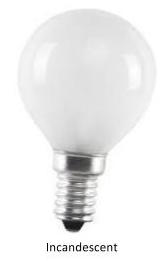
You’ve got four basic types of bulb to choose from these days. Incandescent (tried and tested), halogen (the incandescent’s little brother), CFL (that friend you never really got to know), and LED (shiny and new!).
Your incandescent: tried and tested over time - the bulb you grew up with. This is the normal 60 watt bulb that is - or was - easy to grab, change, and boom! Light. They usually cast that inviting, yellowish glow, and make you feel like home.
However, they are incredible energy-hogs and use far too much power compared to their newer counterparts. Lots of the energy they use becomes heat instead of light, so while you are lighting the room, you’re heating the bulb to a crazy temperature. You’ve probably been victim to one at some stage - it blows while you’re working in the room, and you try to change it too quickly, soon finding that touching a hot plate in the kitchen is a fair comparison.
They also don’t last very long at all, when compared with other bulbs. These are big parts of why they are being phased out of use - not completely, but enough that you need to understand the alternatives.
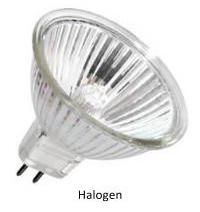 Your halogen: the incandescent’s little brother - always seems to have more energy than its older brother, but gets overheated easily needs to sit down. They are a little more energy-efficient than incandescents, making them a bit nicer to use, but they do put out more heat, making them a little risky to use in certain places.
Your halogen: the incandescent’s little brother - always seems to have more energy than its older brother, but gets overheated easily needs to sit down. They are a little more energy-efficient than incandescents, making them a bit nicer to use, but they do put out more heat, making them a little risky to use in certain places.
These have been known to pose a fire risk if improperly placed, and their slightly lower power usage isn’t much of a draw card when you look at all sides, so there are still better options than the halogen.
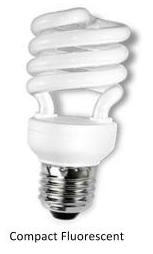 Your CFL: that friend you’ve seen around, but you never really got to know who they are. A CFL is a compact fluorescent. “Fluoro” usually conjures an image of a long tube of flickery, too white light, but a compact fluorescent can go in most light fittings where your incandescent goes. CFLs are considerably better at using the energy that powers them - about 80% better than incandescents - meaning they save you money on power bills. They also last longer, so changing the bulbs happens far less often.
Your CFL: that friend you’ve seen around, but you never really got to know who they are. A CFL is a compact fluorescent. “Fluoro” usually conjures an image of a long tube of flickery, too white light, but a compact fluorescent can go in most light fittings where your incandescent goes. CFLs are considerably better at using the energy that powers them - about 80% better than incandescents - meaning they save you money on power bills. They also last longer, so changing the bulbs happens far less often.
They are usually avoided because of the colour of light they emit - too white, a bit clinical - even though you can now choose different “colours”. They also can flicker, which can be quite annoying, and are those lights that take a second or so to fully turn on when you hit the switch. They contain tiny amounts of mercury, which can be a safety hazard if they break - all of those points are where the last option comes in.
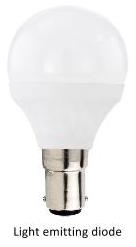 Your LED: shiny and new technology that you probably don’t know all that much about. LEDs are light emitting diodes. Sounds complicated, I know. Put simply, they give light in a more energy-efficient way than even CFLs, don’t get hot at all while on, last longer than CFLs, and don’t flicker or hesitate to give you light when you ask for it. Sounds great, right?
Your LED: shiny and new technology that you probably don’t know all that much about. LEDs are light emitting diodes. Sounds complicated, I know. Put simply, they give light in a more energy-efficient way than even CFLs, don’t get hot at all while on, last longer than CFLs, and don’t flicker or hesitate to give you light when you ask for it. Sounds great, right?
Well, they are pretty great. They cost a bit more to buy, and while they fit in most ordinary fittings, they don’t fit in all. Their downfalls are few and far between, their advantages are many, and they save you more money than CFLs in the long run. And they don’t contain any hazardous material - in fact they are mostly made of recyclable materials.
So those are your most common bulb options - but what about the wattages, lumens, and temperatures?
What wattage for what bulb?
You might be used to looking at the wattage to see how bright your light will be - but this is inaccurate with all the options nowadays. The wattage is actually the amount of power the bulb will use to put out a certain amount of light. With the different options using all different amounts of power to put out the same amount of light, you can’t just look at the wattage anymore.
Remember the 60 watt equivalent bulb from earlier? That means it was either a halogen, CFL, or LED that would put out an equivalent amount of light as a 60 watt incandescent. What you really need to look at to see how bright the light will be is the lumens.
“What the heck is a lumen?” you ask? It’s a standardised unit of measuring light output. It’s the measurement you have kind of been using when you compare a 60 watt bulb to a 40 watt - your mind was comparing how much light you’d get from each one, but you were saying the wrong words. How much light you’ll get is determined by the lumens. Your average 60 watt incandescent puts out roughly 800 lumens, so that’s the number you want to look for instead of the wattage.
The table below shows what wattages correspond to what lumen output across the different types of bulb.
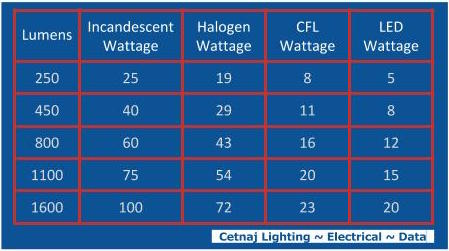
These are approximate conversions, and can differ slightly depending on the brand of bulb, space in which you use the bulb, and what source you’re looking at for information - but if you stick close to this, you should be right.
Now, what was that other decision you still have to make before you buy? Temperature - but not temperature as you know it.
What temperature can a light bulb be?
This doesn’t mean hot or cold to touch. Measured in Kelvin (K), this kind of temperature pertains to the “colour” of light that you get. That warm, yellowish glow of a standard incandescent? That means it’s a low temperature bulb. The slightly clinical, white light of a fluoro? That’s a medium temperature bulb.
Here’s another table to help get your head around the temperature scale, and what temperature relates to the kind of “colour” light you want.
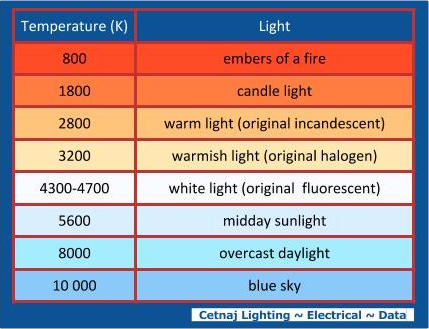
At the lowest end of this scale is infrared light, and the highest end is ultraviolet light.
The temperature range you’ll find for bulbs is usually between 2500 and 6500. You can get most light bulb types in any of these colours - it just depends on your taste and the area you’ll be lighting with it.
So now that you’re not bewildered by the different terms and options (or was that just me?), buying your next light bulb should be a breeze. Keep this guide to buying the right light bulb and these handy tables on file if you forget exactly what lumen output or temperature you need - then go forth, and let there be light! Well, the right light bulb, at least.


